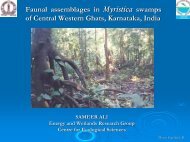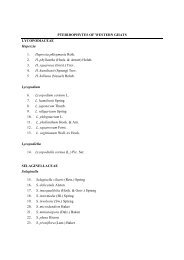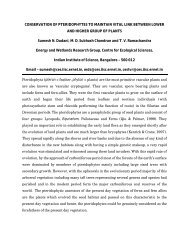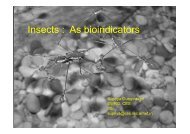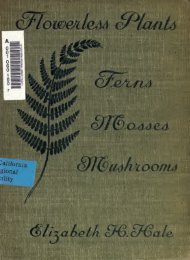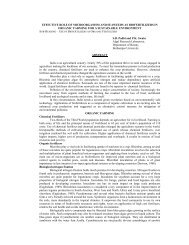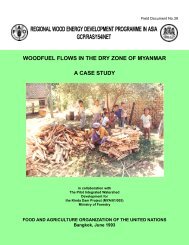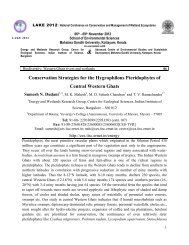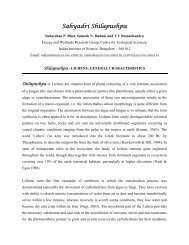Diversity of freshwater mollusc in the Western Ghats - CES (IISc)
Diversity of freshwater mollusc in the Western Ghats - CES (IISc)
Diversity of freshwater mollusc in the Western Ghats - CES (IISc)
Create successful ePaper yourself
Turn your PDF publications into a flip-book with our unique Google optimized e-Paper software.
<strong>Diversity</strong> <strong>of</strong> <strong>freshwater</strong> <strong>mollusc</strong><br />
<strong>in</strong> <strong>the</strong> <strong>Western</strong> <strong>Ghats</strong><br />
N.A. Arav<strong>in</strong>d* and N.A. Madhyastha**<br />
Suri Sehgal Centre for Conservation Science,<br />
Ashoka Tr Trust st for Research <strong>in</strong> Ecolog Ecology and <strong>the</strong> En Environment ironment<br />
(ATREE), Bangalore- 560024.<br />
**Malacology Centre, Poorna Prajna College, Udupi- 576101.
DIVERSITY OF FRESHWATER MACROINVERTEBRATES
HABITAT DIVERSITY OF FRESHWATER ECOSYSTEMS<br />
PONDS LAKES<br />
STREAMS AND RIVERS BACKWATERS AND ESTUARIES
FRESHWATER BIODIVERSITY HOTSPOTS OF THE<br />
WORLD<br />
The <strong>Western</strong> <strong>Ghats</strong> is a hotspot for <strong>freshwater</strong> fishes, crabs and Mollusks
Estimated numbers <strong>of</strong> described and<br />
undescribed terrestrial and <strong>freshwater</strong> <strong>mollusc</strong><br />
Nonmar<strong>in</strong>e N <strong>mollusc</strong> m diversiity<br />
(Number ( <strong>of</strong> sppecies)<br />
70000<br />
60000<br />
50000<br />
40000<br />
30000<br />
20000<br />
10000<br />
0<br />
Terrestrial<br />
Max<br />
M<strong>in</strong><br />
Max<br />
M<strong>in</strong><br />
Undescribed<br />
Described<br />
Freshwater<br />
Source: Lydeard et al. 2004
Taxonomic break up <strong>of</strong> Indian <strong>freshwater</strong> <strong>mollusc</strong> fauna<br />
Gastropods Bivalves Total <strong>Western</strong><br />
<strong>Ghats</strong><br />
Families 12 09 21 13<br />
Genus 36 21 57 20<br />
Species 170 113 214 60<br />
Source: Subba Rao 1989 and Shivaramakrishnan et al. 1999
Arsidopsis footi<br />
Cremnochonchus sahydarensis<br />
Lithtotis rupicola<br />
Arsidopsis sp sp,<br />
Pseudomulleria dalyii<br />
Cremnochonchus sp<br />
Paracrostoma tigr<strong>in</strong>a,<br />
Paracrostoma mart<strong>in</strong>i
Percent speices<br />
70<br />
Habitat preference <strong>of</strong> <strong>freshwater</strong> <strong>mollusc</strong>s<br />
<strong>of</strong> <strong>the</strong> <strong>Western</strong> <strong>Ghats</strong><br />
Rivers and stream are species rich habitats<br />
Habitat distribution <strong>of</strong> Freshwater <strong>mollusc</strong>s<br />
60<br />
50<br />
40<br />
30<br />
20<br />
10<br />
0<br />
Lentic Lotic Both<br />
Habitat<br />
Arsidopsis footi Pseudomulleria dalyi
Zoo-geographically <strong>in</strong>terest<strong>in</strong>g species <strong>in</strong> <strong>the</strong> <strong>Western</strong> <strong>Ghats</strong><br />
Mar<strong>in</strong>e elements <strong>in</strong> <strong>the</strong> <strong>freshwater</strong> <strong>mollusc</strong> fauna<br />
<strong>of</strong> <strong>the</strong> <strong>Western</strong> <strong>Ghats</strong><br />
Nerit<strong>in</strong>ea perottetiana (Neritidae)<br />
Cremnoconchus syhadrensis (Litteror<strong>in</strong>idae)
Zoo-geographical significance <strong>of</strong> <strong>Western</strong> <strong>Ghats</strong> <strong>mollusc</strong>an fauna<br />
Cremnochonchus<br />
Pseudomulleria<br />
Paracrostoma
Cremnochonchus sp.<br />
• Member <strong>of</strong> mar<strong>in</strong>e family<br />
• Shows that Part <strong>of</strong> <strong>the</strong> <strong>Western</strong><br />
<strong>Ghats</strong> was under <strong>the</strong> sea<br />
• Highly specialsed habitat- habitat<br />
waterfalls<br />
• Only on <strong>the</strong> western slopes
Family:<br />
E<strong>the</strong>riidae<br />
Zoo-geographically <strong>in</strong>terest<strong>in</strong>g species <strong>in</strong> <strong>the</strong> <strong>Western</strong> <strong>Ghats</strong><br />
Genus:<br />
3<br />
Species:<br />
3<br />
South America,<br />
Madagascar, Tropical<br />
Africa and India<br />
A Gondwana relict relict, cemented bivalve <strong>of</strong> <strong>the</strong> <strong>Western</strong> <strong>Ghats</strong><br />
Pseudomulleria dalyii y<br />
Only Five populations <strong>of</strong>
Acostea<br />
Colombia<br />
Family E<strong>the</strong>ridae-<br />
A An GGondwanaland d l d relict li t<br />
E<strong>the</strong>ria<br />
Africa and Madagascar<br />
Pseudomulleria<br />
<strong>Western</strong> <strong>Ghats</strong>
Paracrostoma<br />
Brotia<br />
Adamietta<br />
Adamietta<br />
Brotia<br />
… Into India<br />
Adamietta
“…orig<strong>in</strong>s g <strong>of</strong> <strong>the</strong> Indian biota (<strong>freshwater</strong><br />
(<br />
<strong>mollusc</strong>) are more complex and diverse<br />
than assumed under <strong>the</strong> standard<br />
Mesozoic vicariance model…”<br />
Kohler and Glaubrecht 2007
• Food:<br />
Importance<br />
– For humans: Clams, Pila, Thiara etc<br />
– Animals<br />
• Nutrient cycl<strong>in</strong>g: In Terrestrial and Freshwater<br />
• Indicator <strong>of</strong> ecosystem health health-Bio<strong>in</strong>dicators<br />
Bio<strong>in</strong>dicators<br />
• Agricultural pests<br />
• Invasive
Threats
THREAT STATUS OF RIVER CATCHMENTS OF THE<br />
WORLD<br />
River catchments <strong>of</strong> pen<strong>in</strong>sular India is most<br />
threatened
Pollution<br />
Dams<br />
M<strong>in</strong>es<br />
Bivalves<br />
Gastropods<br />
Bivalves Gastropods<br />
Bivalves Gastropods<br />
Agriculture Bivalves Gastropods<br />
Urbanization Bivalves Gastropods
Percentage <strong>of</strong> ext<strong>in</strong>ct animals <strong>in</strong> different<br />
faunal groups<br />
Mollusca<br />
43%<br />
Source: www.redlist.org.<br />
O<strong>the</strong>rs<br />
0%<br />
Amphibians CCrustaceans t<br />
1% 1%<br />
Reptiles<br />
3%<br />
Birds<br />
Fishes<br />
12%<br />
Insects<br />
10%<br />
Mammals<br />
11%
Total number <strong>of</strong> threatened species <strong>of</strong><br />
<strong>mollusc</strong><br />
# sppecies<br />
1400<br />
1200<br />
1000<br />
800<br />
600<br />
400<br />
200<br />
Source: www.redlist.org.<br />
0<br />
1222<br />
708<br />
Trr Terrestrial tril Fr Freshwater h t r<br />
Group<br />
Mr<strong>in</strong> Mar<strong>in</strong>e LLeast tC Concern n rn<br />
41<br />
429
India and <strong>Western</strong> <strong>Ghats</strong>???<br />
OOnly l ONE hhas been b listed li t d under d IUCN red d<br />
list category<br />
Pseudomulleria dalyii
The big challenge <strong>of</strong> <strong>freshwater</strong> biodiversity<br />
Conservation-<br />
Environmental water demand and social requirement
GODAVARI<br />
CATCHMENT<br />
Significant wetlands <strong>of</strong> <strong>the</strong><br />
western ghats and <strong>the</strong>ir<br />
conservation status<br />
Wetland<br />
Habitats<br />
Nos./Region/<br />
Locality<br />
PROTECTION<br />
KRISHNA<br />
CATCHMENT<br />
Rivers 3 large, 13<br />
medium and 17<br />
3 River<br />
Sanctuaries<br />
m<strong>in</strong>or<br />
(Fish)<br />
CAUVERY<br />
CATCHMENT<br />
Backwaters Ashamudi,<br />
Kuttanad,<br />
Vembanad, Kole<br />
wetlands<br />
(Kerala)<br />
2 Ramsar sites<br />
Estuaries/<br />
Mangroves<br />
Bharatapuzha,<br />
Netravathi,<br />
Gurupura,<br />
Gangolli Gangolli,<br />
Sharavathi,<br />
Aghanas<strong>in</strong>i, Kali,<br />
Mandovi<br />
Nil
A Gap Analysis<br />
No comprehensive assessment <strong>of</strong> <strong>freshwater</strong><br />
biodiversity y <strong>of</strong> <strong>the</strong> region g<br />
FFew taxonomic t i studies t di on <strong>freshwater</strong> f h t <strong>mollusc</strong>s ll<br />
Little <strong>in</strong>formation available on <strong>the</strong> distribution<br />
and ecology gy <strong>of</strong> <strong>the</strong> most <strong>of</strong> <strong>the</strong> species p<br />
Few studies on <strong>the</strong> river ecology and its<br />
<strong>in</strong>teraction with o<strong>the</strong>r species
Acknowledgements<br />
Dept. <strong>of</strong> Science and Technology
Endemics
Current Threats (Contd..)<br />
DAMS MINES<br />
MINES AGRICULTURE EXPANSION
Current Threats<br />
RIPARIAN DEFORESTATION WASTE DISPOSAL<br />
INFRASTRUCTURE DEVELOPMENT INDUSTRIAL POLLUTION
Endemism and habitat preference <strong>of</strong> <strong>freshwater</strong> <strong>mollusc</strong>s <strong>of</strong><br />
The <strong>Western</strong> <strong>Ghats</strong><br />
Percent speices<br />
70<br />
Rivers and stream are species rich habitats habitats.<br />
Habitat distribution <strong>of</strong> Freshwater <strong>mollusc</strong>s<br />
60<br />
50<br />
40<br />
30<br />
20<br />
10<br />
0<br />
Lentic Lotic Both<br />
Habitat<br />
Arsidopsis footi Pseudomulleria dalyi



